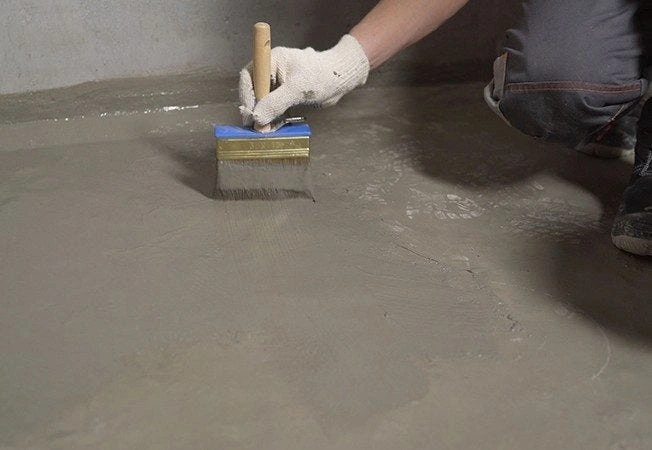Introduction
Crystalline waterproofing may provide a solution if you want your building to last and keep it free from water damage. There has been increasing interest in sustainable building and concerns about long-term durability and rising maintenance costs.
This is why crystalline waterproofing has become a common approach to sealing concrete or concrete masonry from the inside in order to stop water intrusion.
Most traditional approaches to waterproofing involve creating a surface with another material which will protect the structure of the material below.
Crystalline waterproofing works differently by taking advantage of properties that live within the concrete structure to create a permanent moisture barrier.
Table of Contents
This article will cover all you need to know about crystalline waterproofing, including, but not limited to, how it works, advantages, types, application methods, etc.
What Is Crystalline Waterproofing?
Crystalline waterproofing is a method of applying a specially formulated crystalline material to act as a waterproofing agent on concrete. Crystalline waterproofing contains a chemical compound that reacts with moisture and unhydrated cement particles in the concrete.
The reaction results in insoluble crystals forming within the pores, capillaries, and hairline cracks in the concrete, physically blocking the pathways for water.
Crystalline waterproofing treatments can be applied as standalone treatments (i.e. not mixed in with the concrete) or can be applied as admixtures (i.e. mixed in with the concrete).
Crystalline materials, once activated, will form a permanent barrier that becomes part of the concrete. These materials can still offer protection if the surface of the concrete is damaged at a later date.
Why Waterproofing Is Crucial for Building Longevity?
Water is one of the most destructive adversaries of a building. When water enters the concrete, it allows for mold growth, corrosion on the steel reinforcement, followed by the failure of the building structure.
Crystalline Waterproofing Provides:
• Preventions any form of water ingress through hairline cracks.
• Less chance for mold, mildew, and damp patches.
• Enhances the service life of a building.
• Minimizing future repairs and maintenance costs.
Essentially, it not only provides protection but peace of mind for owners and building occupants.
How Crystalline Waterproofing Works?
1. Crystalline Structures Growth in Concrete

When the crystalline waterproof agent (in either a slurry or liquid format) is applied and absorbed into the concrete structure, it undergoes a chemical reaction that will produce crystals which expand out and into every pore and crack available in the substrate.
These crystals will grow indefinitely as long as moisture is present. To put it simply, it establishes a long-lasting, water-resisting network within the concrete matrix.
2. Chronology to Block Water Penetration
In lieu of producing only a surface layer, as in many traditional waterproofing methods, crystalline waterproofing provides an internal barrier.
By doing so, it turns concrete into a water-resistant material, while still allowing concrete to breathe. In essence, it will store vapor as it allows liquid water not to penetrate.
Types of Crystalline Waterproofing Products
There are different types of crystalline waterproofing products to accommodate varying construction specifications:
Powder Admixture: This is added to concrete at the batching stage. It enhances the concrete and gives long-term waterproofing from the start.
Coating & Membrane: Typical applications to waterproofing already completed work; they coat the top of cured concrete. The top surface absorbs the coating or membrane and starts the process of crystalline growth.
Integral Crystalline Admixture: As the name suggests, it is an admixture added to the concrete while it is being made. During the curing process, the admixture will react with moisture, unhydrated cement, etc., creating crystals throughout the structure.
Benefits of Crystalline Admixture:
1. Durability and Longevity
Once applied or mixed with the concrete itself, crystalline waterproofing products will continue to be active for the life of the concrete. In case of new moisture later on, the crystalline reaction reactivates, demonstrating their self-healing ability.
2. Save Money by Reducing Maintenance
By preventing moisture damage in the first place, crystalline waterproofing products eliminate the need for frequent repairs, repositioning, or patching.
3. Chemical Resistant
The crystalline structure also provides protection against harmful chemicals found in soil or groundwater that would erode the quality of the concrete.
4. Sustainability and Eco-Friendliness
Less repair and a longer lifespan means crystalline waterproofing has a smaller carbon footprint. Many of the products are either non-toxic or safe to use in water-containing structures such as ponds and water tanks.
Application Methods: Pre-Construction and Post Construction
Pre-Construction Application
Surface Coating. Before pouring concrete, crystalline slurry can be coated unto the foundation system surfaces, creating a protective layer.
Admixture. Crystalline waterproofing admixtures are formulated mixed into the concrete, before any pours. Typically crystalline admixtures are a solution or powder that is blended into the concrete, allowing the crystalline waterproofing to be distributed further into the concrete.
Post-Construction Application
Surface Application. The liquid crystalline solution or slurry is simply applied directly onto cured concrete. Crystalline waterproofing is used to retrofit, seal or repair any type of concrete surface.
Crack Repair. Crystalline waterproofing is exceptional for sealing fine cracks and porous surfaces. Crystalline waterproofing can simply be pumped or injected directly into fine cracks and the crystalline will regenerate the water resistant elements.
Key Factors Affecting Crystalline Waterproofing
1. Surface Preparation
Concrete surfaces must be clean. Concrete surfaces must also be dry. There should not be any previous coating on the concrete surface or debris. If there is cracking or holes on the concrete surfaces those must be filled prior to application.
2. Material Quality
Select high-grade crystalline waterproofing products or admixtures that comply with industry standards. Higher quality products, set a higher standard. Higher-grade crystalline waterproofing products, are typically constructed with more reactive materials, and often last longer, and outlast regular waterproofing products in harsh environments.
3. Application skill
The application procedures are of real importance.
Choose craftsmen or professionals familiar with crystalline materials and experienced with new construction and retrofitting.
4. Environmental Conditions
Crystalline waterproofing will be most successfully employed in moderate temperature and humidity circumstances. Extremely hot or cold circumstances may require special handling.

Conclusion
Crystalline waterproofing is not just another layer of waterproofing—it is a long-lasting solution that reinforces the durability and structural integrity of buildings from within their walls.
It does not matter whether it is a new application or a retrofit; crystalline waterproofing provides more protection and durability than other approaches.
By reducing the likelihood of repairs, crystalline waterproofing provides building owners with building durability that withstands the test of time.
If you use a well-designed crystalline waterproofing admixture and perform due diligence when applying the product every time, you will be creating long-term health for your building.
Crystalline waterproofing is a proactive solution for engineers, architects ,and property owners who care about sustainability and resiliency.
FAQs
What are the limitations of crystalline waterproofing?
It is not going to work particularly well on poorly compacted concrete, or on concrete that has dynamic (moving) cracks.
What is crystalline waterproofing used for?
It can be employed as waterproofing on foundations, basements, tunnels, water tanks, bridges, and any structure when protection against moisture is important.
Where can I use crystalline waterproofing?
It can be used on new and existing concrete surfaces—walls, slabs, roofs, and
How long does it take for crystalline waterproofing to cure?
Typically, the surface dries within a few hours, but full crystal formation may take 7–14 days depending on conditions.
Sagar Telrandhe is a Construction Engineer with a B.Tech in Construction Engineering & Management. Passionate about infrastructure development, project planning, and sustainable construction, he specializes in modern construction techniques, project execution, and quality management, contributing to efficient and innovative building.


